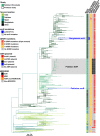A Race against Time: Reduced Azithromycin Susceptibility in Salmonella enterica Serovar Typhi in Pakistan
- PMID: 32699118
- PMCID: PMC7376502
- DOI: 10.1128/mSphere.00215-20
A Race against Time: Reduced Azithromycin Susceptibility in Salmonella enterica Serovar Typhi in Pakistan
Abstract
Antimicrobial resistance is an ongoing issue in the treatment of typhoid fever. Resistance to first-line antimicrobials and extensively drug resistant (XDR) Salmonella Typhi isolates in Pakistan have left azithromycin as the only remaining effective oral treatment. Here, we report the emergence of organisms with a single point mutation in acrB gene, implicated in azithromycin resistance, in a S. Typhi isolate from Pakistan. The isolation of this organism is worrisome and highlights the significance of the introduction of typhoid conjugate vaccine in South Asia.IMPORTANCE The emergence of XDR Salmonella Typhi in Pakistan has left azithromycin as the only viable oral treatment option. Here, we report the detection of an azithromycin resistance-associated mutation in one S. Typhi isolate. This finding is important because any possible spread of azithromycin resistance in S. Typhi isolates would make it nearly impossible to treat in outpatient settings due to the need of injectable antibiotics. Our findings also signify the importance of introduction of typhoid conjugate vaccine in regions of endemicity such as Pakistan.
Keywords: Pakistan; Salmonella Typhi; antimicrobial resistance; azithromycin higher MIC; typhoid fever.
Copyright © 2020 Iqbal et al.
Figures

References
MeSH terms
Substances
LinkOut - more resources
Full Text Sources
Medical
